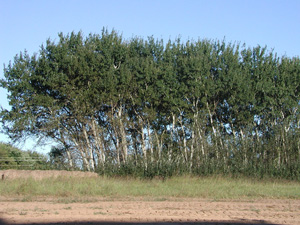Resource Library
Plant of the Week: White Poplar (Silver Poplar)
The University of Arkansas System Division of Agriculture does not promote, support or recommend plants featured in "Plant of the Week." Please consult your local Extension office for plants suitable for your region.
Plant of the Week
White Poplar or Silver Poplar
Latin: Populus alba

I’ve never met a tree I didn’t like. But – there is always a “but” – there are many trees I would never consider planting or recommend anyone else plant. One of these is the white or silver-leafed poplar (Populus alba), a beautiful tree by many standards, but a train wreck when planted in the garden.
Silver-leafed poplar is one of the three dozen or so species of poplars found in the northern hemisphere. Poplars belong to the willow family, so they share a fondness for moist locations and a well-deserved reputation for fast growth, weak wood and short lives. Silver poplar is native to Southern Europe and Central Asia, where it grows along stream banks, not on mountain slopes like its close relatives, the aspens.
Silver poplar grows 30 to 50 feet tall with the main trunk sometimes attaining a girth of 12 to 18 inches. However, by the time the original tree has attained even modest size, it usually has thrown up an ever-expanding thicket of slender suckers from the original tree roots. In lawn situations, round-crowned silver poplars will occasionally be seen without the surrounding coppice of suckers, but they are only kept at bay by the action of the mower.
Trees have a mostly upright habit, with trunks white while young (the source of the white poplar name) and resembling a non-peeling white-barked birch. As the trunks reach six inches in diameter, diamond shaped lenticels begin to populate the trunk, and over time the bole becomes gray in color.
The most beautiful feature of the white poplar is the silvery tomentosum on the underside of the leaf. In even a slight breeze, the leaves tremble and quake – first exposing the dark green upper surface and then flashing the silvery underside – giving the impression of a school of minnows glinting as they reflect the rays of the sun. The leaves are 3 to 4 inches long, with three to five rounded lobes. Trees have no significant fall color. The flowers are produced in catkins and have no ornamental significance. Here in the southland I see no signs that this tree spreads by seeds, but most states consider it a weed species, so perhaps seed regeneration is common in cooler, moister climates.
Silver poplar has been grown in European gardens since at least the late 16th century. It made its way to America by 1784, first being planted in William Hamilton’s Woodlands Garden near Philadelphia, which was the first American arboretum. By the late 1700s, American nurserymen had discovered Lombardy poplar (P. nigra ‘Italica’), and the easily propagated silver poplar became a stock item in the newly emerging and expanding nursery trade.
By the time of the Civil War, poplars were being spoken of despairingly because of their mindless overuse – much as gardeners today look down upon Bradford pears. But they were still cheap, easily transplanted and widely adaptable, and by the end of the 19th century had been planted in every state of the Union. Canker disease effectively removed the Lombardy poplar from the American landscape, but the silver poplar, while susceptible to the disease, was never decimated by it, remaining here and there as a vestige of a bygone era. Today, the USDA map shows silver poplar growing in every state except Arizona and two of the western Canadian provinces. It is hardy in zones 3 through 9.
By: Gerald Klingaman, retired
Retired Extension Horticulturist - Ornamentals
Extension News - January 13, 2012
The University of Arkansas System Division of Agriculture does not maintain lists of retail outlets where these plants can be purchased. Please check your local nursery or other retail outlets to ask about the availability of these plants for your growing area.